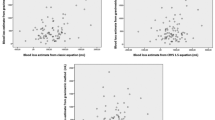Abstract
Objective
The possibility of using a color contrast method to evaluate blood loss during liposuction was assessed. A color chart of blood–lipid content associated with different blood volumes was developed.
Methods
Three color cards with different concentrations of blood were developed based on clinical parameters. The color cards were used to evaluate the volume of blood present in liposuction solutions obtained from 60 clinical liposuction patients. The red blood cell count also was evaluated for each patient. The data obtained using each evaluation method were compared and statistically analyzed to determine the most accurate calculation formula.
Results
The red blood cell counts were compared to the color card results. The paired t test results for the calculated values for the 3:1, 2:1, and 1:1 color cards and the red blood cell count values were comparable (44.3 ± 22.1 ml vs. 53.6 ± 25.0 ml, t = 10.5; 45.4 ± 19.0 ml vs. 55.2 ± 20.7 ml, t = 18.1; 41.9 ± 25.6 ml vs. 52.8 ± 28.3 ml, t = 14.0). The P values were < 0.05, and the difference between the two groups was statistically significant. The average standard error of the mean was 0.90, 0.54, and 0.77, respectively. Sixty samples were evaluated in a scatter diagram using the two detection methods. Trend analysis revealed that the two results demonstrated a linear increase (y = 5.6 + 1.1x), R2 = 0.989, indicating that the two inspection methods were highly correlated with only small errors.
Conclusion
The colorimetric card protocol developed in this study could quickly, accurately, and conveniently calculate blood volumes in liposuction fluids, which has considerable clinical significance.
No Level Assigned
This journal requires that authors assign a level of evidence to each submission to which Evidence-Based Medicine rankings are applicable. This excludes Review Articles, Book Reviews, and manuscripts that concern Basic Science, Animal Studies, Cadaver Studies, and Experimental Studies. For a full description of these Evidence-Based Medicine ratings, please refer to the Table of Contents or the online Instructions to Authors http://www.springer.com/00266.







Similar content being viewed by others
References
Rodríguez-García FA, Sánchez-Peña MA, de Andrea GT et al (2022) Efficacy and safety of tranexamic acid for the control of surgical bleeding in patients under liposuction. Aesthet Plast Surg 46(1):258–264. https://doi.org/10.1007/s00266-021-02486-y
Wu S, Coombs DM, Gurunian R (2020) Liposuction: concepts, safety, and techniques in body-contouring surgery. Cleve Clin J Med 87(6):367–375. https://doi.org/10.3949/ccjm.87a.19097
Kanapathy M, Pacifico M, Yassin AM, Bollen E, Mosahebi A (2021) Safety of large-volume liposuction in aesthetic surgery: a systematic review and meta-analysis. Aesthet Surg J 41(9):1040–1053. https://doi.org/10.1093/asj/sjaa338
Abdelaal MM, Aboelatta YA (2014) Comparison of blood loss in laser lipolysis vs traditional liposuction. Aesthet Surg J 34(6):907–912. https://doi.org/10.1177/1090820X14536904
Bertheuil N, de Runz A, Varin A, Carloni R, Francois C, Chaput B (2017) Concomitant liposuction reduces complications of vertical medial thigh lift in massive weight loss patients. Plast Reconstr Surg 139(2):569e–5570. https://doi.org/10.1097/PRS.0000000000002976
McKibben NS, Lindsay SE, Friess DM, Zusman NL, Working ZM (2022) Methods of quantifying intraoperative blood loss in orthopaedic trauma surgery: a systematic review. J Orthop Trauma 36(6):e215–e226. https://doi.org/10.1097/BOT.0000000000002313
Karmo FR, Milan MF, Silbergleit A (2001) Blood loss in major liposuction procedures: a comparison study using suction-assisted versus ultrasonically assisted lipoplasty. Plast Reconstr Surg 108(1):241–247. https://doi.org/10.1097/00006534-200107000-00039. (discussion 248-9)
Wylęgała A, Mazur R, Wylęgała E (2019) Disseminated intravascular coagulation after liposuction. Ophthalmology 126(9):1287. https://doi.org/10.1016/j.ophtha.2019.05.023
Author information
Authors and Affiliations
Corresponding author
Ethics declarations
Conflict of interest
The authors declare that they have no conflicts of interest to disclose.
Human or Animal Rights
This article does not contain any studies performed by any of the authors that utilized human participants or animals.
Informed Consent
Informed consent was not required for this type of study.
Additional information
Publisher's Note
Springer Nature remains neutral with regard to jurisdictional claims in published maps and institutional affiliations.
Supplementary Information
Below is the link to the electronic supplementary material.
Supplementary file1 (MOV 6877 kb)
Rights and permissions
Springer Nature or its licensor (e.g. a society or other partner) holds exclusive rights to this article under a publishing agreement with the author(s) or other rightsholder(s); author self-archiving of the accepted manuscript version of this article is solely governed by the terms of such publishing agreement and applicable law.
About this article
Cite this article
Li, XB., Kang, CY., Zhang, XF. et al. Assessment of Blood Volume in Liposuction Fluids Using Colorimetry. Aesth Plast Surg 48, 1457–1464 (2024). https://doi.org/10.1007/s00266-023-03547-0
Received:
Accepted:
Published:
Issue Date:
DOI: https://doi.org/10.1007/s00266-023-03547-0




